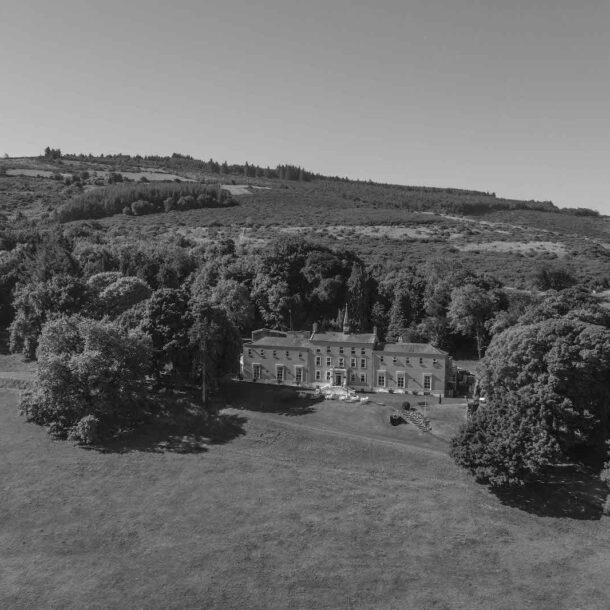

Close

Irene and Hugh Dewhusrt bought Dungarthill from the Cox family in 1947. The purchase inaugurated a new period of peace for the young couple and their family after the tumult of World War II. Hugh had served in the army, while Irene had taken her two young children to live with their grandparents in Wales. Buying Dungarthill was also a homecoming for Irene: In nearby Perth, her father and uncle had built the whiskey empire that brought her family from its crofting roots to the nobility.
Her grandfather, John Dewar, was born to a poor family of tenant farmers in 1806. His diligence in school won him a job with a relative who was a successful wine merchant in Perth when he was 20. Twenty years later, he broke out on his own and set up his own proprietary blend of Scotch Whiskey, the much sought-after White Label. His two sons expanded the business into an international brand with soaring profits.
Before successful blenders like the Dewars took over the whiskey trade in Scotland, it was a cottage industry that produced a product of extreme variance. Whiskey was a local beverage largely unknown outside Scotland. Highland distillers produced an all-malt whiskey by soaking sacks of barley in bog water until it sprouted, and then drying it over peat fires. Sometimes they topped off the sacks with excess potatoes or other fermentables, and some flavored their whiskey with botanicals associated with gin, like herbs and flowers. Their product ranged from pale and fragrant to heavy, oily and extremely alcoholic. Distributors often adulterated whiskey with water, dye, and spices to increase their profits. The innovation of blenders like the Dewars was to draw from many Scottish distilleries to make a more homogenous product that could be shaped to the taste and budget of customers from Boston to Hong Kong. Each of the great Scottish whiskey families—the Walker, Dewars, and Buchanans—claim the honor of being the first to bottle their blends. Before bottling, whiskey was only sold in casks to hotels and public houses. Bottling opened up the alcohol industry we know today.
John Dewar’s two sons’ diverging personalities carved out symbiotic places for them in the family business. John Alexander, Irene’s father, was a dour, sedulous man with a penchant for finance and administration. Thomas, or “Whiskey Tom” as he became known, was a charismatic committed bachelor who sold Scotch whiskey to the world. Tasked with promoting the Dewar White Label Scotch in London, a twenty-three-year-old Tom tried to get the family blend into a brewers’ show at the Agricultural Hall, but he was denied entrance. Tom, never one to give up, took up his bagpipes and blared them outside the show as loudly as he could and refused to stop. His antics did not earn him a spot among the brewers, but it did get him the attention and business of the high-end wholesaler Spiers & Pond.
In the 1880s, John won a massive line of credit from a Scottish firm. Armed with thousands of pounds, Tom launched a two-year, worldwide tour to bring Dewar whiskey to the world. The tour was an enormous risk for the Dewars: They spent £14,000 on the tour at a time when their profits were just £7,000 a year. Tom started his journey in Boston, journeyed across America to San Francisco, sailed to Hawaii, and then made his way through the islands of the Pacific and into China. He won consignments and appointed agents in each of the 26 countries he visited. Because of Whiskey Tom, Scotch became a worldwide phenomenon with worldwide demand. By 1896, Dewar was the global market leader of whiskey. Tom wrote a popular book about his journey and bachelor adventures called Ramble Round the Globe. Dewar’s annual profits soared from £1,321 when the first John Dewar died in 1880 to £59,000 in 1900 to over £1,000,000 when Dewar merged with the other great whiskey firms of Scotland.
In 1897, the brothers built their own distillery, Aberfeldy, within sight of the croft where their father grew up. There, they crafted their own single malt. Aberfeldy is still active today and has won awards for its Scotch whiskey. The distillery is just a 30-minute drive from Dungarthill, and guests can visit for whiskey tastings, tours, and a museum about the Dewar story.
The Dewar brothers’ dispositions differed as much in politics as in business. Tom was a staunch Conservative and Unionist, while John Alexander was a Liberal. He served on the Perth town council and on other local committees where he pursued liberal causes like local housing and improved sanitation. In 1907, he was made a baronet and in 1916 joined the peerage as Baron Forteviot of Dupplin, making him the first of the “whiskey barons.” On Dupplin, an estate he bought from an earl in 1910, he built a model village and tried to improve the quality of life of the tenant farmers who lived in poverty much as his own grandfather had. He donated tens of thousands of pounds—several million in today’s money—to philanthropic causes. He also chaired two public inquiries into the medical services in the Highlands and remote islands of Scotland that uncovered a complete lack of care and helped establish affordable medical services in impoverished rural counties.
John’s daughter, Irene, carried on her father’s public-minded spirit when she joined the many women who performed civic duties at home while their husband served in World War II. Irene’s older brother, John, inherited the family title and much of the Dewar fortune, but Irene was still a whiskey heiress. Her grandfather had been born into a crofting family and yet she lived as a member of the British aristocracy. Dungarthill was a rural retreat fit for the daughter of any baron, whether of the whiskey variety or the conventional, more established sort, and her son attended Eton, the most prestigious boarding school in England.